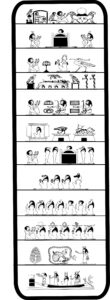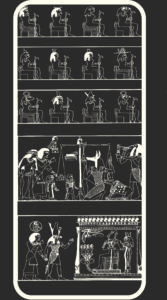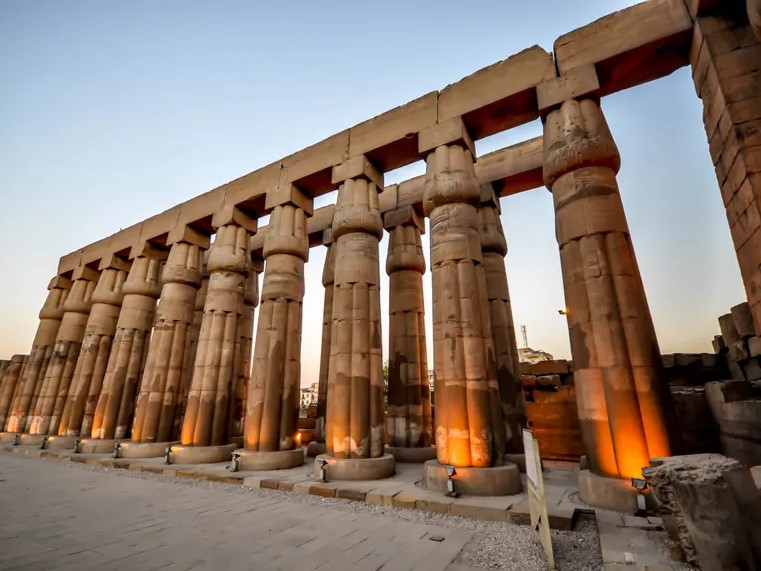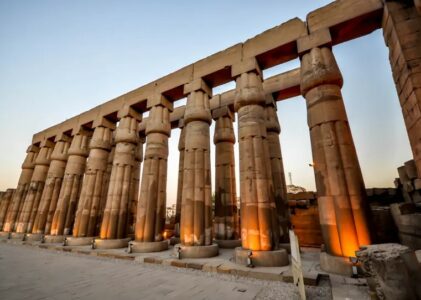The cypher documents did not mention anything specific to be placed on the black and white pillars. Instead, all that was required were two emblems of spiritual evolution. The early versions of the Isis-Urania pillars were blank, other than images of the Kerubs at the top.
But there was a move to place vignettes from the Egyptian Book of the Dead, specifically Chapters 21 and 17. Chapter 21 was the famous Judgement scene of the dead, while Chapter 17 was a more obscure system of occult knowledge and ritual challenges. The Vignettes did not have the accompanying ritual text, and indeed some illustrations needed to be included. The versions we see today were all taken from the Papyrus of Ani, which dates their use to after 1888, the year they were presented to the British Museum. However, Mathers could not have seen the papyrus symbols that he would insist were placed on the pillars until 1888; indeed, it is possible he would not have studied them until the first facsimile of the Papyrus was issued in 1890.
 This prevents them from being the inspiration for the Golden Dawn rituals. But Mathers must have had some access to a Book of the Dead because the material from it ended up inside the Golden Dawn rituals. as there are parts of the Book of the Dead which were lifted wholesale and put fragments into the rituals.
This prevents them from being the inspiration for the Golden Dawn rituals. But Mathers must have had some access to a Book of the Dead because the material from it ended up inside the Golden Dawn rituals. as there are parts of the Book of the Dead which were lifted wholesale and put fragments into the rituals.
For the development of the Golden Dawn rituals, Mathers must have used an earlier Book of the Dead, which was in circulation. For example, Karl Richard Lepsius published a translation of a manuscript dated to the Ptolemaic era in 1842. It is to him we owe the name “Book of The Dead” and the spell numbering system. The most likely candidate was the Papyrus of Nebseny, which had been published in 1876 by Samuel Birch of the British Museum.
But none of these provided the images to be placed on the pillars. These were copied from the Papyrus of Ani.
Mathers might have known of the Ani papyrus earlier than most, as he haunted the British Museum and its reading room at the time, but it is unlikely that he could have copied the vignettes before they were made public.
 But the Ani Papyrus was important. When Mathers created the Z documents in Paris, it became an essential part of the magical mechanics of the 0=0 ritual. The 0=0 took place in the Judgement Hall of Maat, and the Inner Structure of the physical temple was modelled after the Book of the Dead description in Ani. This was almost undoubtedly possible because Mathers had access to a viable translation of Ani after it had been printed by E. A. Wallis Budge in 1895.
But the Ani Papyrus was important. When Mathers created the Z documents in Paris, it became an essential part of the magical mechanics of the 0=0 ritual. The 0=0 took place in the Judgement Hall of Maat, and the Inner Structure of the physical temple was modelled after the Book of the Dead description in Ani. This was almost undoubtedly possible because Mathers had access to a viable translation of Ani after it had been printed by E. A. Wallis Budge in 1895.
Mathers placed the 21st chapter of the Book of the Dead on the Black Pillar. In many ways, this was a no-brainer. The Black Pillar represented the blackening, the black robe of the Neophyte, and so the Judgement scene was a good symbol of the first order. The vignettes showed Ani being led into the temple of Maat, where he was judged by the 42 assessors, which was a perfect description of what was supposed to be happening in the 0=0 according to the Z documents.
But the white pillar, which was supposed to represent the Second Order, was less pronounced. Mathers settled on the mysterious 17th chapter.
The chapter was interesting because it read like a ritual and fitted into many masonic and magical preconceptions that the Ancient Egyptians practised magical initiations. This was given extra weight because the chapter contained the explanation that it was a:
“Formulae for elevation and transfiguration, for going out from the necropolis, for being in the following of Osiris, and being content with the food of Wennefer, going out by day, taking any form desired to be taken, playing the board-game senet, being in the pavilion, a living soul, the Osiris [the dead person) among the revered before the great Ennead in the west, after he moors. This is good for the one who does it on earth. The words come to pass, in completion.”
In other words, if you carried out the sequence shown in the text while you were still alive, you would help you join something like a craft guild of the divine.
But the chapter could also be a simple mnemonic. The information was considered necessary, so it was presented as a question-and-answer challenge to help the person remember it.
The chapter was one of the most extended and other versions of the Papyrus, which have appeared have been much longer and contained more detailed information. What made it a good chapter for the second order is that it mapped out the inner landscape for the candidate to travel.
In the first vignette, Ani, who to Mathers would represent the candidate, pay a game of senet or drafts. This game meant a staged progression through the afterlife.
Connected to this was the ritual phrase These are the words of Osiris N:
“Mine is all in existence alone in Nun; I am Ra in his rising, first in ruling what he made.”
This is a perfect statement for one who has just undergone the 5=6 initiation, which is all about the Solar force. Rather than an outer order or personality, it is the understanding of the Solar self and moving through the stages of the underworld. Rather than being passive, he is ruling the universe which he has made.
The following vignette represents Osiris leaving the tomb and “coming forth by day.” As far as the Golden Dawn symbolism was concerned, this was after the candidate left the tomb holding the weapons of Osiris.
As the Chapter says:
“It means Ra created his body when those gods in the following of Ra took shape.” The candidate is unopposed among the gods.”
As the candidate goes through each of the vignettes, they are exposed to the various forces until they incorporate them and master them.
Throughout all of these experiences, the Osiris is given affirmations and knowledge.
“Atum in his sun disk, or it is Ra in his sun disk shining from the eastern horizon of the sky. Mine is yesterday; I know tomorrow.”
Osiris is seen as being “yesterday”, the time before death, and the black pillar, while “Tomorrow is Ra”, which is the work of the adept. It is “tomorrow” that the rebels against the One Thing are destroyed, and when Horus is appointed.
Some of the pillars give instructions for the journey through the afterlife and explain what is there.
“It is Rosetau; it means the southern gate at Naref; it means the northern gate, the mound of Osiris. And as for the lake of what is Right, it is Abydos or the road on which his father Atum goes when he journeys to the Marsh of Reeds.”
It also gives the names of those beings who will stand guard on the adept’s sphere of sensation, which we know are the sons of Horus. There are some additional names so that seven spirits are said to protect the adept.
Those seven spirits are Nedjehdjeh-slumberer, Bull-that-cannot be-given-fire, Foremost-of-his flame, Entering-of-sight-who-is-in-his-hour, Red-eyed-of-the-following-of-the-Temple-of-Red, Shining-faced-coming-out-backwards, Seeing-by-night-fetching-by-day.
One character in this chapter is Mau, the great cat, who rarely gets mentioned in other Ancient Egyptian literature. It disproportionally receives a mention in the Golden Dawn outer grade work.
“I am that great cat beside whom the ished-tree was split in Iunu on that night of active battle and making the guard against the rebels on that day on which the enemies of the Lord of All were destroyed.”
He is shown in this chapter cutting up the enemies of Ra with a knife.
As the adept progresses through this chapter, he is given powers of transformation, which are similar to the experiences of out-of-the-body experiences of inner realities.
The adept is said to be a follower of the Lord of All by the writings for transformations. He can fly as a falcon and cackle as a goose, and as a result, he can never perish.
Throughout this process, the adept is tested and goes through many trials. The chapter includes spells designed to see off the danger.
Finally, the adept emerges and is left with the vignette of a lion sitting on a shrine.
The chapter tells us that the lion, white-mouthed, flat-headed, is the phallus of Osiris (or Ra, depending on the version of the text). He has become a creature of pure power.
It seems logical, and Mathers and his eventually loyal lieutenant John Brodie-Innes wrote several papers on the pillars and their meanings.
However, something made Stella Matutina change its mind. While all the paperwork seems unchanged, there was a move within Stella Matutina to flip the vignettes from the black pillar to the white ones. We know this was done at Whare Ra, and the pillars are preserved. Indeed, the reality of the flipped pillars was made only noticed when it was pointed out by the Felkin Society Trust.
It has been spotted before, but little has been made of it. Pat Zalewski wrote in his Golden Dawn Ritual Commentaries book (pp.127-132) that the impetus came from a paper written by Brodie Inness. Although Inness had not suggested anything as radical as flipping the images, his paper inspired Whare Ra to make some changes.
The central reason was that the idea of sacrifice was not adequately developed on the pillars but was crucial to the 5=6 ritual. The various vignettes of the “black pillar” could be attributed to the three points of the 5=6 ritual. With some tinkering, what was placed on the White Pillar could equally be attributed to the outer order.
Changing this required some surgery to the sashes within Whare Ra.
But this was not universal within the Stella Matutina. Israel Regardie did not know about it in Bristol. All the material from the UK used the traditional pillar attributions. Tony DeLuce wrote on my blog that the SM swapped the shoulders, and the sashes were worn. The Golden Dawn and the A.O. wore the black sash on the right shoulder and the white sash on the left shoulder.
From a practical perspective, Whare Ra got it wrong. It may not have been the fault of Felkin but simply the isolation from the UK about what Chapter 17 represented. There was a common assumption within Whare Ra that Chapter 17 represented a sequence of symbolic barring, which was close to what happened in the 0=0. Translations of Chapter 17 show that this was not the case, and the candidate was only being questioned. There is not much other symbolism which could be related to the 0=0.
To Whare Ra adepts, the scales represented the cross of suffering in the 5=6 ritual, with the rest of the images representing the resurrection. However, it required them to ignore that according to the Z documents, the Hall of the Neophytes was the Judgement Hall of Maat. By placing the symbol on the white pillar, Felkin had made a prominent symbol on the black pillar obscure, and the obscure symbolism of the white pillar incomprehensible.

